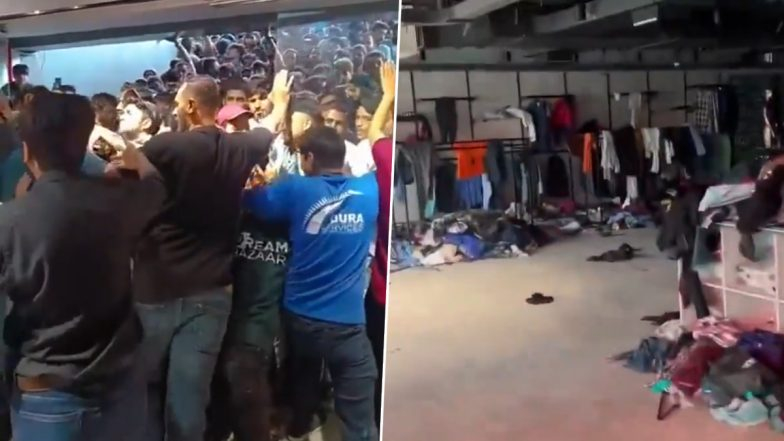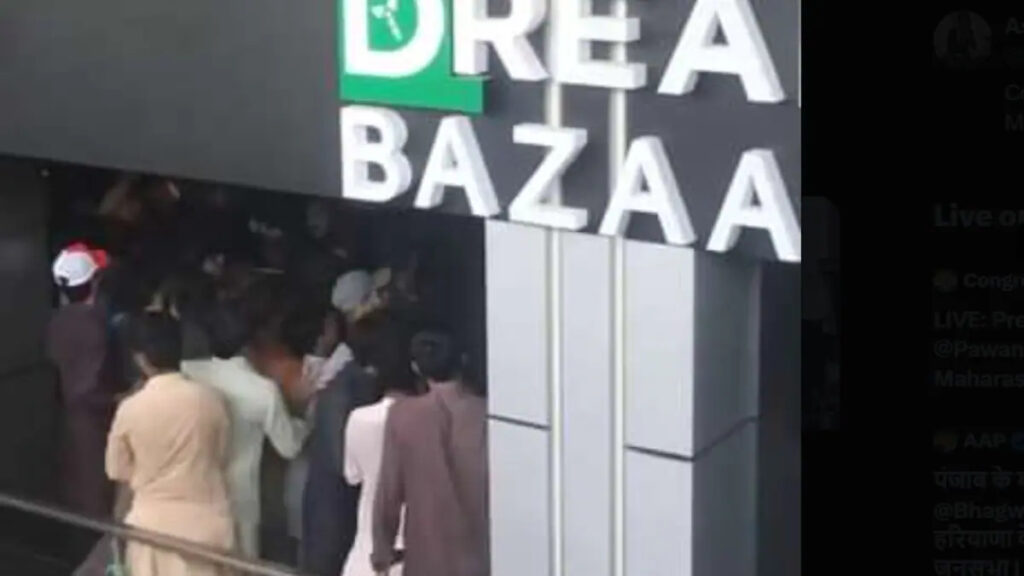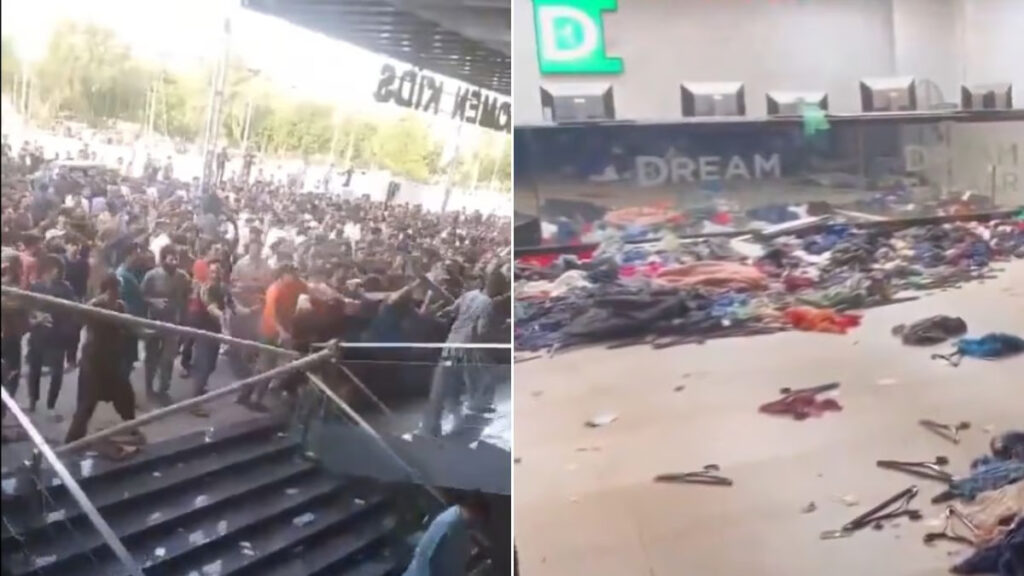The much-anticipated grand opening of Pakistan’s Dream Bazaar Mall in Karachi was supposed to be a milestone event, symbolizing progress and modernity in one of the country’s busiest cities. Built by a Pakistani businessman living abroad, this new shopping center was promoted as a haven for shoppers, offering everything from international brands to local favorites. However, what was meant to be a celebration of retail success quickly descended into chaos, looting, and destruction, raising serious questions about security, societal norms, and the responsibilities of both businesses and law enforcement. This blog delves into the events of that fateful day, the public’s reaction, and the broader implications for Pakistan’s retail landscape and social fabric.
The Build-Up to a Grand Opening
Dream Bazaar Mall, located in Karachi’s bustling Gulistan-e-Johar area, was designed to be a beacon of modernity and luxury. Its development was spearheaded by a Pakistani expatriate, whose vision was to create a world-class shopping experience that would bring a slice of international retail to the heart of Karachi. With state-of-the-art architecture, a wide range of stores, and a promise of unparalleled shopping convenience, Dream Bazaar was set to transform the shopping landscape in Karachi.
The marketing campaign for the mall’s grand opening was extensive. Social media platforms like Facebook, Instagram, and Twitter were abuzz with advertisements and promotional videos showcasing the mall’s luxurious interiors, the variety of shops, and the special discounts that would be available on the opening day. These promotions generated considerable excitement, with many Karachi residents marking their calendars for what was expected to be a landmark shopping event.
The opening day was set for a Friday, a strategic choice given that it is a day off for many people in Karachi, thus ensuring maximum turnout. The mall’s management anticipated a large crowd but perhaps underestimated just how much interest their marketing efforts would generate. By 3:00 pm, the time set for the grand opening, a large crowd had gathered, eager to be among the first to experience what Dream Bazaar had to offer.
The Chaos Unfolds: From Celebration to Catastrophe
SHOCKING NEWS 🚨 Massive chaos erupts as Dream Bazaar Mall in Karachi is looted right after its Grand Inauguration!
Built by a foreign businessman in Gulistan-e-Johar, the mall was offering special discounts for locals when things spiraled out of control.
The entire world is… pic.twitter.com/902kRvHBxZ
— INM24 Updates 🚨™ (@inm24news) September 1, 2024Despite the festive atmosphere and high hopes, the grand opening took a disastrous turn almost immediately after the doors opened. The scene that unfolded at Dream Bazaar Mall was one of pure chaos. What should have been a controlled, orderly entrance quickly devolved into a free-for-all. Eyewitnesses describe scenes of pandemonium as the crowd surged forward, overwhelming the security personnel and forcing their way into the mall.
Viral videos circulating on social media captured the madness as hundreds of people pushed, shoved, and jostled to get inside. The security guards, who were clearly unprepared for such a large turnout, were powerless to control the mob. In the chaos, people were seen climbing over barriers, knocking over displays, and rushing toward the stores in a desperate bid to be the first to grab the heavily discounted goods.
Once inside, the situation rapidly deteriorated. What began as a shopping frenzy quickly escalated into outright looting. Shoppers-turned-looters ransacked stores, grabbing whatever they could find. Clothes, electronics, and other valuable items were taken without hesitation, as people stuffed merchandise into bags, pockets, and even carried items away in their arms. The mall’s management and staff, though they tried to manage the situation, were overwhelmed by the sheer number of people and the level of aggression they encountered.
Vandalism and Looting: The Aftermath
As the crowd swelled, so did the chaos. Shops were ransacked, with looters smashing windows, tearing down displays, and scattering merchandise across the floor. The scene resembled a battlefield more than a shopping center, with the mall’s sleek interiors marred by the destruction. Clothes were strewn across the floors, shattered glass from display cases and windows littered the premises, and merchandise was thrown about haphazardly.
The extent of the damage was staggering. Virtually every store in the mall suffered some form of damage or theft. Video footage captured the aftermath of the rampage, revealing a scene of utter devastation. The entire building was left in shambles, with the once orderly and elegant shopping environment transformed into a chaotic mess. Eyewitnesses reported seeing people gleefully filming themselves as they looted, seemingly proud of their actions. This lack of remorse or fear of consequences was a stark illustration of the breakdown of order and respect for property.
A Void of Security and Law Enforcement
A Huge Mall Dream Bazar was built by a Pak foreign businessesman in Karachi, Pakistan- On it's inauguration yesterday he offered special discount for Pakistani locals….. and the whole Mall was looted pic.twitter.com/ah4d2ULh3l
— Megh Updates 🚨™ (@MeghUpdates) September 1, 2024One of the most glaring issues highlighted by this incident was the absence of effective security measures. Despite the mall’s high-profile opening and the expected large turnout, security personnel were either too few or too ill-prepared to handle the situation. The lack of adequate planning and coordination with local law enforcement left the mall vulnerable to the kind of mob behavior that ensued.
Security personnel on site were overwhelmed almost immediately. They were not equipped to deal with a crowd of this size and aggression. Once the crowd began to force its way in, there were no mechanisms in place to manage the influx or deter the looters. The security guards on duty were quickly overpowered, unable to contain the surging masses.
Perhaps more troubling was the apparent absence of police presence. Videos and eyewitness reports indicated that police officers were not present during the height of the chaos. By the time law enforcement did arrive, the damage was already done, and the looters had dispersed. The lack of a timely police response raised serious questions about the preparedness and effectiveness of Karachi’s law enforcement agencies in handling such situations. The failure to prevent or respond effectively to the looting highlighted deficiencies in both private security and public law enforcement.
Public Reaction: Outrage, Disgust, and Debate
The looting of Dream Bazaar Mall sparked widespread outrage and disgust among the public, both in Pakistan and abroad. Social media platforms were flooded with reactions, with many expressing shock at the scenes of chaos and destruction. Commenters lamented the lack of civic sense and respect for law and order, with some pointing to the incident as a reflection of deeper societal issues.
One user wrote, “It’s unfortunate to see such an exciting development turn into a chaotic situation. While the intention behind offering special discounts to locals was admirable, it’s clear that better planning and security measures were needed to prevent the mall from being looted.” Another commented, “What else can you expect from a country where lawlessness is the norm? A place where even a generous gesture turns into chaos. This incident speaks volumes about the state of affairs in Pakistan.”
These comments highlight the frustration and disappointment felt by many, not only at the events that transpired but also at the broader implications for Pakistani society. The incident was seen by some as symptomatic of a culture where respect for property and law is often lacking, and where opportunities for theft and vandalism are too readily seized. The looting of Dream Bazaar Mall is more than just an isolated incident of vandalism; it is a reflection of broader societal and economic issues in Pakistan. The scenes of chaos and lawlessness speak to deep-seated frustrations and a lack of trust in authorities and institutions.
A Deeper Look: What Went Wrong?
Several factors contributed to the chaos at Dream Bazaar Mall’s opening. First and foremost was the lack of adequate security planning. Given the extensive publicity and the promise of discounts, the mall’s management should have anticipated a large crowd and taken steps to ensure order. This could have included hiring additional security personnel, coordinating with local law enforcement for support, and implementing crowd control measures such as barriers and controlled entry points.
The failure to plan for such contingencies left the mall vulnerable to the kind of mob behavior that ensued. Once the crowd began to push its way in, there were no mechanisms in place to manage the influx or deter the looters. The security personnel on site were insufficient in number and, evidently, in training, to handle a crowd of that size and aggression.
Moreover, the absence of a swift police response compounded the problem. In any situation involving large crowds and potential for unrest, a visible police presence can serve as a deterrent to criminal behavior. The delay in police intervention allowed the looting to continue unchecked, resulting in significant damage and loss.
The Role of Social Media: Catalyst or Culprit?

Social media played a dual role in the Dream Bazaar incident. On the one hand, it was a powerful tool for promoting the mall’s opening, generating excitement and drawing in customers. The use of platforms like Facebook, Instagram, and Twitter allowed the mall’s management to reach a broad audience quickly and effectively.
However, social media also played a role in the chaos that unfolded. The same platforms that advertised the discounts and opening day festivities became conduits for the spread of looting videos, fueling the frenzy. Once the looting began, videos of the chaos went viral, attracting more people to the scene and exacerbating the situation. The allure of being part of a viral moment, coupled with the opportunity for quick gains, likely motivated some individuals to join in the looting.
The role of social media in such incidents is complex. While it serves as a powerful tool for marketing and engagement, it can also act as a catalyst for unrest, spreading information rapidly and sometimes inciting further disorder. The speed at which videos of the looting went viral highlights the double-edged nature of social media in today’s connected world.
Broader Implications: What This Incident Means for Pakistan

The looting of Dream Bazaar Mall is more than just an isolated incident of vandalism; it is a reflection of broader societal and economic issues in Pakistan. The scenes of chaos and lawlessness speak to deep-seated frustrations and a lack of trust in authorities and institutions. For many, the mall represented a rare opportunity for access to goods and luxuries that are often out of reach. The breakdown of order suggests a desperation that is fueled by economic hardship, inequality, and a sense of disenfranchisement.
Moreover, the incident raises serious concerns about the state of law and order in Pakistan. The failure to prevent or respond effectively to the looting highlights deficiencies in both private security and public law enforcement. For investors and businesses, the incident serves as a cautionary tale, underscoring the risks associated with operating in an environment where security cannot be guaranteed.
The looting also has implications for the retail sector in Pakistan. The damage to Dream Bazaar Mall is not only physical but also reputational. The images of chaos and looting will linger in the minds of potential shoppers, making them wary of visiting the mall. For the businesses operating within the mall, the incident represents a significant financial loss, both in terms of stolen merchandise and the cost of repairs. For the broader retail industry, the incident serves as a reminder of the importance of security and the need for effective planning and risk management.
Learning from the Nightmare: Steps Forward

In the aftermath of the Dream Bazaar incident, there are several lessons to be learned. For businesses, especially those planning large-scale events or openings, the importance of thorough security planning cannot be overstated. This includes not only hiring adequate security personnel but also coordinating with local law enforcement and implementing crowd control measures. The failure to plan for such contingencies left the mall vulnerable to the kind of mob behavior that ensued. Once the crowd began to push its way in, there were no mechanisms in place to manage the influx or deter the looters. The security personnel on site were insufficient in number and, evidently, in training, to handle a crowd of that size and aggression.
For law enforcement agencies, the incident is a reminder of the need for readiness and rapid response capabilities. Ensuring public safety and maintaining order in the face of large crowds requires not only personnel but also training, equipment, and a clear protocol for action. The delay in police intervention allowed the looting to continue unchecked, resulting in significant damage and loss.
Finally, for society as a whole, the looting of Dream Bazaar Mall is a call to reflect on the values and behaviors that are shaping Pakistan’s social landscape. The scenes of chaos and destruction are a sobering reminder of the need for greater civic education, respect for law, and a commitment to building a society where progress and prosperity can be achieved without descending into disorder.
Conclusion: Dream Bazaar’s Legacy
The grand opening of Dream Bazaar Mall was meant to be a symbol of progress and prosperity, a testament to the potential for growth and development in Karachi. Instead, it became a symbol of chaos and lawlessness, a stark illustration of the challenges facing Pakistan’s retail sector and society at large. While the mall’s looting is a tragic setback, it also provides an opportunity to learn, adapt, and build a more resilient and orderly future. By addressing the underlying issues that led to the chaos, Pakistan can work towards ensuring that dreams of progress do not turn into nightmares of destruction.
Dream Bazaar’s legacy, therefore, is twofold. On the one hand, it serves as a cautionary tale about the risks of inadequate planning, security, and social instability. On the other hand, it offers a chance to reflect on the broader societal issues at play and to take steps towards building a more secure, orderly, and prosperous future. The lessons learned from the chaos of Dream Bazaar’s opening day must be heeded if Pakistan is to avoid similar incidents in the future and to ensure that the dreams of progress and development can be realized without descending into disorder and destruction.





